Azum DNA
Metabolic Profile - What is it and why you need it?
Get personal advice on Azum
Simply reserve a consultation appointment - and we will show you Azum directly and personally.
Training control: Individual metabolic profile versus FTP
The goal of coaches is the optimal preparation of their athletes for competitions. This includes a well thought-out training management, well-planned rest periods and a steady increase in performance up to day X. Training management is a complex and comprehensive process. In addition to the choice of a suitable training frequency and the appropriate training hours, it also includes a sensible division and distribution of the training intensity (Seiler, 2016). Some coaches work with three intensity levels, others with five, seven or even more. Some coaches prefer a lot of intensive training, others less. Regardless of these preferences, it is important to remember that the bodies of all athletes have different physiological conditions. Accordingly, it is problematic to generalise intensity requirements and to lump all athletes together. However, this is exactly what happens when defining training zones based on percentage derivations of a given value, like the famous FTP. In practice, however, many coaches have adopted such a value – often FTP. This is an inadmissible simplification from the point of view of training science. Coaches who want to provide their protégés with individual and goal-oriented support cannot avoid taking the metabolism of the individual person into account. Individual metabolic profiles are the only way to tailor the training of athletes. This article describes the advantages of training control using metabolic profiles and shows that intensity control using percentage derivations of FTP makes little sense from a training science point of view.
What is FTP?
FTP stands for „Functional Threshold Power“. It is mainly used in cycling and indicates the power in watts that an athlete can produce at maximum effort over a period of 60 minutes. This index can be determined by means of simple field tests. A common method is to test at maximum intensity for 20 minutes and then multiply the average power by a factor of 0.95. This allows the maximum average power of the athlete to be estimated over a period of 60 minutes (Allen & Coggan, 2010).
The problem of FTP
First of all, FTP is often mistakenly equated with individual anaerobic threshold (IAT) or maximal lactate steady state (MLSS). With IAT and MLSS, there is a balance between lactate build up and breakdown. This is often not the case with FTP (Inglis et al., 2020; Jeffries et al., 2019). In comparison to the lactate threshold, the FTP does not reflect a physiological process (Mackey & Horner, 2021). Studies have shown that in well-trained cyclists, FTP correlates well with IAT in many cases (Borszcz et al., 2019). However, this does not apply to less well-trained athletes (Valenzuela et al., 2018). In any case, there is a high degree of uncertainty as to whether there is a correlation. When determining the FTP, multiplication by the usual factor of 0.95 is subject to error. It is an estimate that varies in accuracy depending on the training status of the athlete and the warm-up protocol of the FTP test. Various studies have shown that, depending on the subject, a factor of 0.89 to 0.95 must be applied for the power at which a MLSS occurs (Borszcz et al., 2019; Inglis et al., 2020; Lillo-Beviá et al., 2019). This results in considerable differences as an outcome of the FTP test. Another problem is that the FTP test is subject to a learning effect (Mackey & Horner, 2021). Depending on the experience gained in performing the test, it may be more or less successful. Accordingly, different values are recorded whose difference cannot be explained by physiological processes. Well, even if the FTP would always reflect the IAT 100% truthfully, deriving training ranges from it would remain problematic. There is only one key figure and the FTP does not allow any conclusions to be drawn about how the performance was achieved. It remains unknown which energy sources the athlete tapped into and to what extent.
“When looking at FTP, it remains unknown which energy sources the athlete tapped into and to what extent”
FTP is therefore a key figure that offers us little added value. We cannot derive from it which metabolic processes take place in an athlete. Accordingly, no serious training guidelines can be made on the basis of FTP alone (Jeffries et al., 2019). If we do so anyway, we run the risk of missing the desired metabolic adaptations. In any case, we cannot coach athletes according to individual circumstances. Let’s take a look at why it is important to know metabolic processes for training control in a short excursus.
Excursus: Energy supply of the body
In order for us to move, individual muscle cells with tiny microfilaments must contract and relax again; this process is called contraction. For this, our body needs energy in the form of adenosine triphosphate (ATP). ATP is the universal energy supplier of the cells. We obtain energy from food, i.e. from carbohydrates, fat and, to a certain extent, protein. The human organism stores energy reserves in various places to be able to draw on them efficiently during physical exertion, such as sport. In endurance sports, the focus is on the macronutrients carbohydrates (sugar) and fat as energy suppliers. Carbohydrates are delivered directly to the muscles via the blood in the form of glucose or they are stored in the form of glycogen in muscle and liver cells. Fats are stored in different places in the body, including the muscles. Other energy suppliers, such as ATP or creatine phosphate (KrP) already stored in the muscle, are only dealt with in passing here because they play a subordinate role in endurance sports. Our body can provide energy via the aerobic („with oxygen“) or the anaerobic („without oxygen“) pathway. Which of these pathways provides the main part depends strongly on the intensity of the strain and accordingly also on the duration of the strain. However, there is always a mixture of aerobic and anaerobic energy supply. If we need as much energy as possible quickly, the anaerobic system is the dominant supplier (high flow rate). If the intensity is low and we need energy over a long period of time, the aerobic system has the upper hand. Although it is slower in providing energy, it is almost inexhaustible. During anaerobic energy production, glucose is metabolised in the cell plasma (glycolysis). Glycolysis itself generates energy (ATP). The end product is lactate. Lactate is an energy source for the aerobic metabolism. However, when the aerobic metabolism is not able to use all the lactate for energy – because lactate production is faster then lactate combustion – then lactate will accumulate. In this process pH level drops. The athlete has to reduce the exercise intensity. Aerobic energy production (cellular respiration) is carried out in the mitochondrion (the power plant of the muscle cell). Carbohydrates and fatty acids are metabolised. In aerobic carbohydrate metabolism, the end product of glycolysis, lactate, is processed (aus der Fünten et al., 2013).
Figure 1
Aerobic and anaerobic energy production
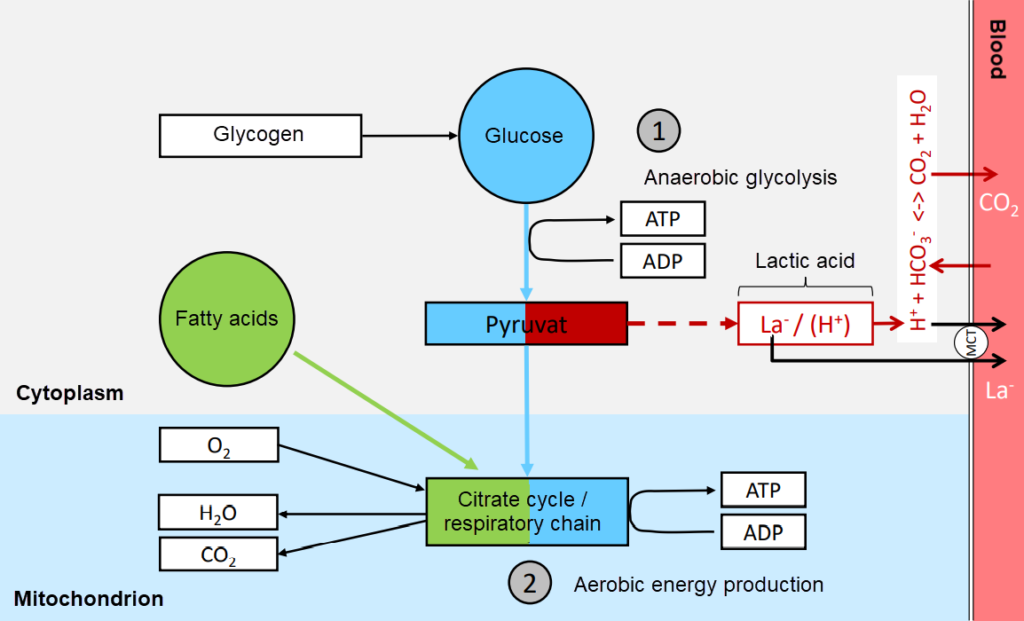
Figure 2 shows how the energy supply during sporting activities develops over time. It can be seen from these examples that considerable individual differences can occur.
Figure 2
Energy supply over time
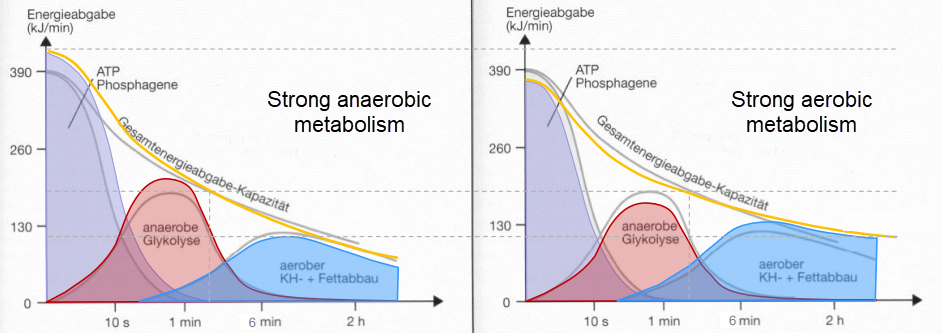
Training control based on FTP
After this excursus, let’s get back to training control. We have seen that the provision of energy is achieved in different ways, varies from person to person and is quite complex. The processes that take place in the body are greatly simplified, but in reality they are many times more sophisticated. However, to dissect this in detail would go beyond the scope of this article. Nevertheless, it is clear that simply pedalling with all your might for 20 minutes and planning your training based on that is an inadmissible simplification. Training control via percentage derivations of FTP does not do justice to the complex and highly individual metabolic processes. If two cyclists perform an FTP test and achieve exactly the same result (watts per kilo of body weight), the energy required for this may come in different proportions from the aerobic and anaerobic metabolism. However, since the FTP test does not give us any information about this, we simply define the intensity zones in the same way for both athletes using percentage derivations. It is obvious that this does not take into account individual circumstances and that we may be going in the wrong direction with our training. Accordingly, training control based on a single key figure such as FTP is not advisable!
Figure 3
Problematik bei der Trainingssteuerung nach FTP

Training control through individual metabolic profiles
A reliable and scientifically valid method is training management by means of individual metabolic profiles. An individual metabolic profile shows the metabolic state of an athlete at different intensities. Such a profile is collected in a performance diagnostic. This can be a lactate step test, spiroergometry, a combination of both or a metabolic simulation with software such as INSCYD. These methods provide a different number of findings. Depending on the choice of diagnostic form and test protocol, the following physiological parameters can be determined: • Maximum oxygen uptake (V̇O2max) • Lactate production rate (V̇Lamax) • Anaerobic threshold • Ventilator thresholds I and II • Energy demand • Maximum fat oxidation • Carbohydrate combustion The following applies to all methods: Insights into metabolism can be gained that an FTP test does not provide. Based on the results of such diagnostics, coaches can create individually tailored training programmes. The desired training effects can be targeted and the corresponding metabolic processes triggered. The risk of missing or undesired adaptations or overtraining is minimised.
Integration of the metabolic profiles in the Azum training platform
The Swiss training and coaching platform Azum is the market-leading software for the integration of individual metabolic profiles. Regardless of the form of diagnostics, the collected performance values can be transferred to the profile of the respective athlete via interface (INSCYD) or manually (all others). Profiles for different sports can be stored for each athlete. The corresponding values are automatically transferred to the planned training sessions and always show the athletes which intensity they have to aim for (power, pace, heart rate). This functionality guarantees a high training quality and an exact control of the desired intensity zones. It enables coaches to provide healthy, individual and efficient support to athletes.
Figure 4
Metabolic profile in Azum
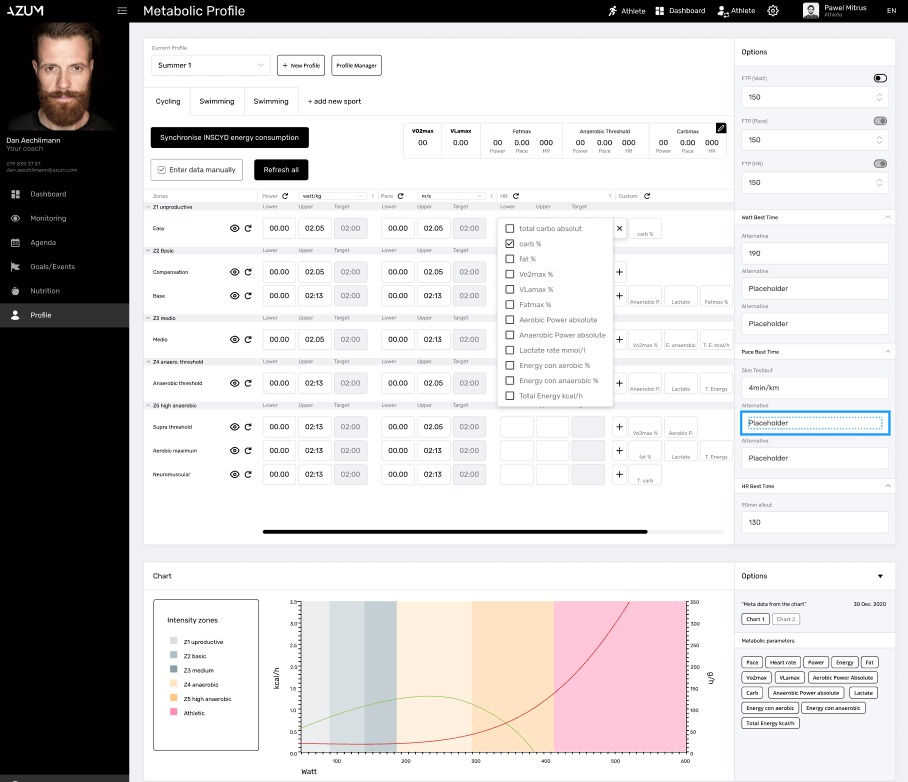
Coaching based on energy consumption
t is no longer a secret that besides training, nutrition also plays a decisive role in performance development. The excursus on energy supply has shown that in almost all cases carbohydrates are the critical point. Carbohydrate stores are limited, glycogen cannot be stored in the muscles at will. Accordingly, care must be taken with these stores. Not only in competitions will there be a drastic drop in performance if the carbohydrates are all burned, but also in training it is always important to keep an eye on this. It is often underestimated how many carbohydrates are metabolised in a training week. In order to keep an overview of the energy consumption, and even to adjust the training accordingly, Azum offers the possibility to base the training planning on it. Besides the integration of power, pace and heart rate values from a diagnostic, this is another crucial functionality. Every kilocalorie, every gram of fat and every gram of carbohydrate metabolised at a given intensity can be stored in the metabolic profile. The data can in turn be integrated automatically (INSCYD) or manually (for example from a spiroergometry). Based on the planned training, Azum shows the consumption for individual intervals, for whole training sessions, for days or even for complete weeks.
Figure 5
Planned training in Azum
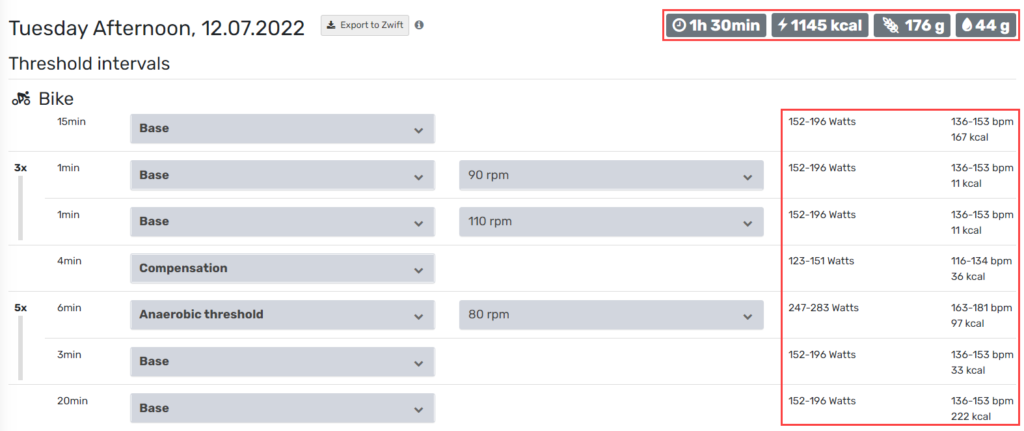
Together with the stored basal metabolic rate, it is possible to plan very precisely how much energy an athlete consumes and what is reasonable. This can be a great help, especially in training-intensive phases such as a training camp. It shows what it means to cycle for 5 hours and how much carbohydrate is actually consumed. Accordingly, the training can be precisely controlled and it can be ensured that the athletes do not get into a catabolic state. In addition, this functionality can be used to create nutrition strategies for before, during and after training. The nutrition plans can be written directly in the platform.
Figure 6
Planned energy consumption versus planned energy intake in Azum
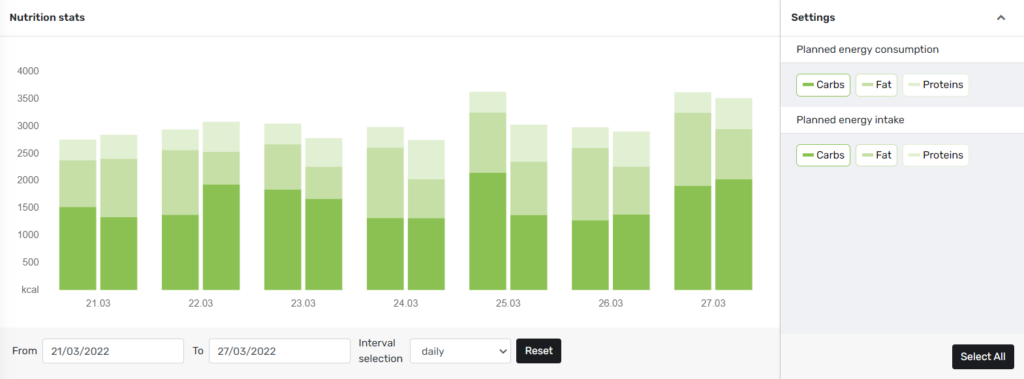
Conclusion
Contemporary training management should be oriented towards the sports science standard that we have at our disposal in the 21st century. The simplification of training athletes based on an FTP value is negligent and does not correspond to good coaching. As coaches we are dealing with people who entrust us with their health and their time. We should not put these highest goods and the trust placed in us by the athletes at risk by using a training plan that is based on a rule of thumb. The highest standard must be applied here! Instead of an FTP test, we should regularly carry out serious performance diagnostics with our athletes to determine their individual metabolic profile. The training and coaching software Azum enables us to integrate the values directly into the training management and thus to accompany the athletes in the best possible way on their athletic path.
Bibliography
Allen, H., & Coggan, A. (2010). Power-based training: Where to begin. Training and Racing With a Power Meter. Boulder, CO: Velo Press, 39–52.
aus der Fünten, K., Faude, O., Hecksteden, A., Such, U., Hornberger, W., & Meyer, T. (2013). Anatomie und Physiologie von Körper und Bewegung. In A. Güllich & M. Krüger (Eds.), Sport: Das Lehrbuch für das Sportstudium (pp. 69–73). Springer. https://doi.org/10.1007/978-3-642-37546-0_5
Borszcz, F. K., Ferreira Tramontin, A., & Pereira Costa, V. (2019). Is the Functional Threshold Power Interchangeable With the Maximal Lactate Steady State in Trained Cyclists? International Journal of Sports Physiology and Performance, 14(8), 1029–1035. https://doi.org/10.1123/ijspp.2018-0572
Inglis, E. C., Iannetta, D., Passfield, L., & Murias, J. M. (2020). Maximal Lactate Steady State Versus the 20-Minute Functional Threshold Power Test in Well-Trained Individuals: “Watts” the Big Deal? International Journal of Sports Physiology and Performance, 15(4), 541–547. https://doi.org/10.1123/ijspp.2019-0214
Jeffries, O., Simmons, R., Patterson, S. D., & Waldron, M. (2019). Functional Threshold Power Is Not Equivalent to Lactate Parameters in Trained Cyclists. Journal of Strength and Conditioning Research, 35(10), 2790–2794. https://doi.org/10.1519/JSC.0000000000003203
Lillo-Beviá, J. R., Courel-Ibáñez, J., Cerezuela-Espejo, V., Morán-Navarro, R., Martínez-Cava, A., & Pallarés, J. G. (2019). Is the Functional Threshold Power a Valid Metric to Estimate the Maximal Lactate Steady State in Cyclists? Journal of Strength and Conditioning Research, 36(1), 167–173. https://doi.org/10.1519/JSC.0000000000003403
Mackey, J., & Horner, K. (2021). What is known about the FTP20 test related to cycling? A scoping review. Journal of Sports Sciences, 39(23), 2735–2745. https://doi.org/10.1080/02640414.2021.1955515
Seiler, S. (2016). Seiler’s Hierarchy of Endurance Training Needs. https://doi.org/10.13140/RG.2.2.16667.05924
Valenzuela, P. L., Morales, J. S., Foster, C., Lucia, A., & de la Villa, P. (2018). Is the Functional Threshold Power a Valid Surrogate of the Lactate Threshold? International Journal of Sports Physiology and Performance, 1–6. https://doi.org/10.1123/ijspp.2018-0008
Zintl, F., & Eisenhut, A. (2009). Ausdauertraining: Grundlagen. Methoden. Trainingssteuerung. München: BLV Sportwissen.
- Datum: 20. July 2022